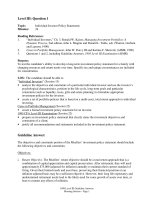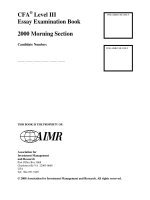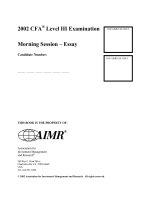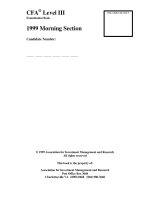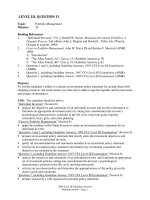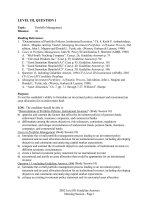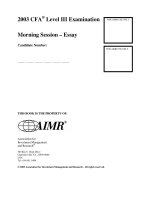L3 mock sample exam CFA level III essay questions 2000
Bạn đang xem bản rút gọn của tài liệu. Xem và tải ngay bản đầy đủ của tài liệu tại đây (105.78 KB, 42 trang )
CFA® Level III
Essay Examination Book
FOR AIMR USE ONLY
2000 Morning Section
Candidate Number:
FOR AIMR USE ONLY
_____ _____ _____ _____ _____ _____
THIS BOOK IS THE PROPERTY OF:
Association for
Investment Management
and Research
Post Office Box 3668
Charlottesville VA 22903-0668
USA
Tel: 804-951-5499
© 2000 Association for Investment Management and Research. All rights reserved.
The following list contains the command words used on the Morning Section of
the 2000 Level III examination. Candidates may want to refer to this list as they
formulate their answers.
calculate
To ascertain or determine by mathematical processes.
compute
To determine, especially by mathematical means.
contrast
To compare in respect to differences.
critique
To offer a critical review or commentary; to criticize.
describe
To transmit a mental image, an impression, or an understanding of the
nature and characteristics of.
discuss
To discourse about through reasoning or argument; to present in detail.
evaluate
To determine or fix the value of; to determine the significance or worth of,
usually by careful appraisal and study.
explain
To give the meaning or significance of; to provide an understanding of; to
give the reason for or cause of.
justify
To prove or show to be valid, sound, or conforming to fact or reason; to
furnish grounds or evidence for.
select
To choose from a number or group—usually, by fitness, excellence, or
other distinguishing feature.
state
To express in words.
The Morning Section of the 2000 CFA Level III Examination has 21 questions.
For grading purposes, the maximum point value for each question is equal to the
number of minutes allocated to that question.
Question
Item Set Book
1–12
Essay Book
13
14
15
16
17
18
19
20
21
Topic
Minutes
Ethical & Professional Standards
36
Portfolio Management
Portfolio Management
Portfolio Management
Portfolio Management
Portfolio Management
Portfolio Management
Economics
Asset Valuation
Asset Valuation
20
12
12
12
22
16
20
16
14
Total:
180
Questions 13 through 15 relate to Robert Taylor. A total of 44 minutes is allocated to these
questions. First review the Introduction below and Exhibit 13-1 on page 3. Candidates
should answer these questions in the order presented.
Introduction
Robert Taylor, aged 50 and a U.S. resident, recently retired and received a $500,000 cash
payment. He also obtained $700,000 through the exercise of stock options. Both figures are net
of tax. Taylor is not entitled to a pension; however, his medical expenses are covered by
insurance paid for by his former employer. Taylor is in excellent health and has a normal life
expectancy.
Taylor’s wife died last year after a long illness, which resulted in devastating medical expenses.
All their investments, including a home, were liquidated to fully satisfy these medical expenses.
Taylor has no assets other than the $1,200,000 cash referenced above, and has no debts. He plans
to acquire a $300,000 home in three months and insists on paying cash given his recent adverse
experience with creditors. When presented with investment options, Taylor consistently selects
the most conservative alternative.
After settling into his new home, Taylor’s living expenses will be $2,000 per month and will rise
with inflation. He does not plan to work again.
Taylor’s father and his wife’s parents died years ago. His mother, Renee, is 72 years old and in
excellent physical health. Her mental health, however, is deteriorating and she has relocated to a
long-term care facility. Renee’s expenses total $3,500 per month. Her monthly income is $1,500
from pensions. Her income and expenses will rise with inflation. She has no investments or
assets of value. Taylor, who has no siblings, must cover Renee’s income shortfall.
Taylor has one child, Troy. Troy and a friend need funds immediately for a start up business.
First year costs are estimated at $200,000. The partners have no assets and have been unable to
obtain outside financing. The friend’s family has offered to invest $100,000 in the business in
exchange for a minority equity stake if Taylor agrees to invest the same amount.
Taylor would like to assist Troy; however, he is concerned about the partners’ ability to succeed,
the potential loss of his funds, and whether his assets are sufficient to support his needs and to
support Renee. He plans to make a decision on this investment very soon. If he invests $100,000
in Troy’s business, he insists that this investment be excluded from any investment strategy
developed for his remaining funds.
With the above information, portfolio manager Sarah Wheeler prepared the investment policy
statement for Taylor shown in Exhibit 13-1.
Return Objective: •
•
Risk Tolerance:
•
Time Horizon:
Liquidity Needs:
Tax:
Legal and
Regulatory:
Unusual
Circumstances:
•
•
•
•
•
•
•
•
•
•
•
•
Exhibit 13-1
Robert Taylor Investment Policy Statement
Income requirement is $2,000 monthly.
Total return requirement is 2.7% annually ($24,000 / $900,000).
Substantial asset base and low return requirement provide ample
resources to support an aggressive, growth-oriented portfolio.
Client is 50 years old, recently retired, and in excellent health.
Time horizon exceeds 20 years.
$300,000 is needed in three months for purchase of home.
Modest additional cash is needed for normal relocation costs.
$100,000 may be needed for possible investment in son’s business.
A normal, ongoing cash reserve level should be established.
There is little need to defer income.
Mother’s expenses may have an effect.
No special considerations exist.
Client desires to support mother.
Client insists that any investment in son’s business be excluded from
long term planning.
Client has strong aversion to debt.
QUESTION 13 HAS TWO PARTS FOR A TOTAL OF 20 MINUTES
A.
Evaluate the appropriateness of Taylor’s investment policy statement in Exhibit 13-1
with regard to the following objectives:
i.
ii.
Return Requirement
Risk Tolerance
(12 minutes)
B.
Evaluate the appropriateness of Taylor’s investment policy statement in Exhibit 13-1
with regard to the following constraints:
i.
ii.
Time Horizon
Liquidity Needs
(8 minutes)
QUESTION 14 HAS ONE PART FOR A TOTAL OF 12 MINUTES
After revising the investment policy statement and confirming it with Taylor, Wheeler is now
developing a long-term asset allocation strategy for him. Wheeler will use the following revised
information to recommend one of the allocations in Exhibit 14-1:
•
•
•
•
•
•
Taylor has decided to invest $100,000 in his son’s business but still insists that this
investment be disregarded in making his allocation decision.
Taylor’s total cash flow needs have changed to $4,200 a month.
The available asset base is $800,000.
Wheeler estimates that the inflation rate will be 1 percent next year.
Taylor is determined to maintain the real value of his assets because he plans to set up
a charitable foundation in the future.
Taylor insists on taking no more risk than absolutely necessary to achieve his return
goals.
Exhibit 14-1
Potential Long Term Asset Allocation Strategies
Allocation Allocation Allocation
B
A
C
Asset Class Weighting
Stocks
20%
40%
60%
Bonds
75%
55%
35%
Cash
5%
5%
5%
Expected Annual
Return
6.7%
7.5%
8.2%
Standard Deviation
9.0%
11.5%
15.3%
Potential for
Asset Growth
Very Low
Low
Moderate
Income Growth
Very Low
Low
Moderate
Current Income
High
High
Low
Stability
Very High
High
Moderate
Allocation
D
80%
15%
5%
9.1%
19.0%
High
High
Very Low
Low
Select the allocation strategy from Exhibit 14-1 that is most appropriate for Taylor, and justify
your selection with two supporting reasons related to the revised information shown above.
(12 minutes)
QUESTION 15 HAS ONE PART FOR A TOTAL OF 12 MINUTES
After five years, Wheeler is reviewing whether Taylor’s investment policy statement is still
appropriate for his situation. She discovers that:
•
•
•
•
Taylor’s expenses have decreased significantly because of the death of his mother.
His net worth has tripled, largely because of profits realized from the sale of his investment
in his son’s business.
Taylor now feels financially secure and plans to invest primarily to provide for future
charitable goals.
Taylor believes the only significant change to his cash flow needs during the next few
months will be a $100,000 gift to a charity.
Wheeler concludes that a revised investment policy statement is needed.
Discuss the effect of Taylor’s new circumstances on the following four components of his
investment policy statement. Your discussion should focus on the direction and magnitude of
change in each factor rather than on a specific numerical change.
i.
ii.
iii.
iv.
Return Requirement
Risk Tolerance
Time Horizon
Liquidity Needs
(12 minutes)
QUESTION 16 HAS ONE PART FOR A TOTAL OF 12 MINUTES
Wheeler has concluded her work with Taylor and is meeting with Don Sampson, a potential new
client. Sampson begins the meeting by outlining his investment philosophy as shown in Exhibit
16-1.
Exhibit 16-1
Don Sampson’s Investment Philosophy
Statement
Number
Statement
1
Investments should offer strong return potential but with very limited risk. I prefer to
be conservative and to minimize losses, even if I miss out on substantial growth
opportunities.
2
All non-governmental investments should be in industry-leading and financially
strong companies.
3
Income needs should be met entirely through interest income and cash dividends.
All equity securities held should pay cash dividends.
4
Investment decisions should be based primarily on consensus forecasts of general
economic conditions and company-specific growth.
5
If an investment falls below the purchase price, that security should be retained until
it returns to its original cost. Conversely, I prefer to take quick profits on successful
investments.
6
I will direct the purchase of investments, including derivative securities,
periodically. These aggressive investments result from personal research and may
not prove consistent with my investment policy. I have not kept records on the
performance of similar past investments, but I have had some “big winners”.
Select the statement from Exhibit 16-1 that best illustrates each of the following behavioral
finance concepts. Justify your selection.
i.
ii.
iii.
Mental Accounting
Overconfidence (illusion of control)
Reference Dependence
Note: Candidates should not select any statement more than once.
(12 minutes)
QUESTION 17 HAS THREE PARTS FOR A TOTAL OF 22 MINUTES
Walter Tobler is considering a substantial change in investment strategy for the portfolio he
manages. His supervisor has raised concerns about the measurement and management of the
increased risks to the portfolio that might result from such a change in strategy. In response to
those concerns, Tobler states:
“Our approach to risk will not change. As we have done in the past, we will monitor both
variance of security returns and tracking error relative to our benchmark. I have looked at
additional risk measurement tools, in particular probability of shortfall and expected
shortfall, but I believe that these measures do not add value to our process.”
A.
Describe the calculation of each of the following four measures of risk:
i.
ii.
iii.
iv.
Variance of security returns
Tracking error relative to a benchmark
Probability of shortfall
Expected shortfall
(8 minutes)
B.
Discuss one unique weakness for each of the following measures:
i.
ii.
iii.
Variance of security returns
Probability of shortfall
Expected shortfall.
(6 minutes)
In response to further questions about whether his risk management system really captures the
riskiness inherent in financial markets, Tobler replies:
“Fortunately, our entire approach to risk management is based on two well-supported
premises: Financial market returns are normally distributed, and financial market
correlations are essentially stable. These two basic conditions will serve to limit our risk
as we move to invest in new markets.”
C.
Critique each of Tobler’s two premises, using the template on page 37. State, for each
premise, one unique implication for Tobler’s approach to risk management.
Answer Question 17-C in the Template provided on page 37.
(8 minutes)
Template for Question 17-C
Premise
Critique of Premise
Financial market
returns are normally
distributed.
Financial market
correlations are
essentially stable.
Unique Implication of Premise
QUESTION 18 HAS FOUR PARTS FOR A TOTAL OF 16 MINUTES
Janice Delsing, a U.S.-based portfolio manager, manages an $800 million portfolio ($600 million
in stocks and $200 million in bonds). In reaction to anticipated short-term market events, Delsing
wishes to adjust the allocation to 50 percent stock and 50 percent bonds through the use of
futures. Her position will be held only until “the time is right to restore the original asset
allocation.” Delsing determines a financial futures-based asset allocation strategy is appropriate.
The stock futures index multiplier is 250 and the denomination of the bond futures contract is
$100,000. Other information relevant to a futures-based strategy is given in Exhibit 18-1.
Exhibit 18-1
Information for Futures-Based Strategy
Bond portfolio modified duration
5 years
Bond portfolio yield to maturity
7%
Basis Point Value (BPV) of bond futures
$97.85
$1378
Stock Index Futures Price
Stock Portfolio Beta
1.0
A.
Describe the financial futures-based strategy needed and explain how the strategy allows
Delsing to implement her allocation adjustment. No calculations are necessary.
(4 minutes)
B.
Compute the number of each of the following needed to implement Delsing’s asset
allocation strategy:
i.
ii.
Bond futures contracts
Stock index futures contracts
(4 minutes)
C.
Discuss one advantage and one disadvantage of using each of the following for asset
allocation:
i.
ii.
Financial futures
Index put options
(4 minutes)
One month later, the yield to maturity on comparable bond portfolios has increased by 10 basis
points and the stock index has risen by $28.
D.
Calculate the percentage return (from price changes only) for the past month, assuming:
i.
ii.
Delsing executed the 50/50 asset allocation strategy using futures.
Delsing did not execute the strategy but instead preserved her original long-term
asset allocation.
(4 minutes)
QUESTION 19 HAS THREE PARTS FOR A TOTAL OF 20 MINUTES
The Board of Directors of Evergreen Pension Fund asked consultant Whitney Hannah to review
two approaches to forecasting economic trends: econometric and consensus.
A.
Discuss whether econometric approaches and consensus approaches to forecasting
economic trends are different or similar with respect to:
i.
ii.
iii.
Role of historical data
Number of analysts reflected in the forecast
Nature of assumptions about future economic relationships
(6 minutes)
B.
State and discuss whether econometric approaches or consensus approaches to
forecasting economic trends are more likely to be distorted by:
i.
ii.
iii.
iv.
Group think
Inability to test sensitivity
Simultaneity
Data mining
(8 minutes)
C.
State and discuss whether econometric approaches or consensus approaches to
forecasting economic trends are more likely to reflect the following strengths:
i.
ii.
iii.
Ability to identify turning points in trends
Ease of construction
Ability to capture multiple market influences
(6 minutes)
QUESTION 20 HAS ONE PART FOR A TOTAL OF 16 MINUTES
Kirby Anderson is reviewing the nature of the data used in constructing two U.S. real estate
indexes. One index, published by the National Association of Real Estate Investment Trusts
(NAREIT), measures the performance of equity real estate investment trusts. The other index,
published by the National Council of Real Estate Investment Fiduciaries (NCREIF), measures
the performance of commingled investment funds.
Anderson is convinced that the two indexes are comparable in terms of the types of real estate
properties, geographic distribution, and market capitalization.
Contrast the NAREIT and NCREIF indexes with respect to:
i.
ii.
iii.
iv.
Source of underlying asset valuation
Leverage (gearing) of underlying assets
Index returns calculated before or after deduction of investment advisory fees
Correlation with broad equity market (e.g., S&P 500 Index)
Answer Question 20 in the Template provided on page 55.
(16 minutes)
Template for Question 20
Characteristic
i. Source of
underlying asset
valuation
ii. Leverage
(gearing) of
underlying assets
iii. Index returns
calculated before
or after
deduction of
investment
advisory fees
iv. Correlation with
broad equity
market (e.g.,
S&P 500 Index)
NAREIT Index
NCREIF Index
QUESTION 21 HAS TWO PARTS FOR A TOTAL OF 14 MINUTES
James Norwood, a fixed income portfolio manager, was recently hired to manage two U.S.
Treasury portfolios for HEY Corporation. These portfolios, shown in Exhibit 21-1, comprise
HEY’s total investments. Norwood noticed that although the yields to maturity and modified
durations of the two portfolios were similar, the portfolios were structured differently.
Exhibit 21-1
Portfolio Characteristics
Characteristics
Portfolio A
2-year maturity
10-year maturity
30-year maturity
0%
100%
0%
50%
0%
50%
7.2
7.7
5.9%
5.8%
Modified Duration
Yield to maturity
A.
Portfolio B
Select and justify the portfolio in Exhibit 21-1 that will provide the higher return in each
of the following scenarios (assume an initial yield curve that is upward sloping). No
calculations are necessary.
i.
An upward parallel shift of 50 basis points in the yield curve.
ii.
A twist in the slope of the yield curve. Two-year interest rates rise by 10 basis
points, while 30-year interest rates decline by 10 basis points.
(8 minutes)
One year has passed. Each investment portfolio now has a total market value of $200 million and
a modified duration of 7.2. HEY’s liabilities now total $180 million and have a modified
duration of 6.
B.
Calculate the effect on HEY’s assets and liabilities if interest rates decline by 100 basis
points (ignore convexity). Show your calculations.
(6 minutes)
CFA Level III Examination
2000 Morning Section
IMPORTANT INSTRUCTIONS TO CANDIDATES
1. Write your candidate number in the spaces provided at the top left corner of the front cover
of this Essay Exam book and of the Item Set Exam book.
2. Instructions for using the Item Set Exam answer sheet (computer scan sheet):
• Use a No. 2 or HB pencil to record your answers on the answer sheet.
• Read and sign the pledge at the bottom of your answer sheet. Write your exam center
code and today’s date on the lines provided in the pledge section.
• Write your name in the spaces provided at the top of the answer sheet. Darken the ovals
that correspond with the letters in your name.
• Write your candidate number in the spaces provided at the top of your answer sheet.
Darken the ovals that correspond with your candidate number.
• Select the best answer for each question and darken the oval that corresponds with your
answer. Only answers recorded on the answer sheet will be graded. Any marks you make
in the exam book will not be graded.
• Do not make any stray marks on the answer sheet.
3. Instructions for using the Essay Exam answer pages:
• Write your answers in blue or black ink on the correct answer pages in the Essay Exam
book.
• Label each part of your answer (A, B, C, or i, ii, iii, etc.).
• Only answers written on the correct answer pages will be graded. You may make marks
and notes on the question pages, but these marks will not be graded.
• If you use all of the designated answer pages, check the box at the bottom of the last page
of your answer and continue your answer on the unnumbered extra pages at the back of
the exam book. Label extra pages with the correct question number.
DO NOT OPEN THIS EXAM BOOK
UNTIL INSTRUCTED TO DO SO BY THE PROCTOR.
DO NOT REMOVE ANY EXAM BOOK OR ANSWER SHEET
FROM THE EXAM ROOM.
CFA® Level III
Essay Examination Book
FOR AIMR USE ONLY
2000 Afternoon Section
Candidate Number:
FOR AIMR USE ONLY
_____ _____ _____ _____ _____ _____
THIS BOOK IS THE PROPERTY OF:
Association for
Investment Management
and Research
Post Office Box 3668
Charlottesville VA 22903-0668
USA
Tel: 804-951-5499
© 2000 Association for Investment Management and Research. All rights reserved.
The following list contains the command words used on the Afternoon Section of the 2000
Level III examination. Candidates may want to refer to this list as they formulate their answers.
calculate
To ascertain or determine by mathematical processes.
cite
To quote by way of evidence, authority, or proof.
construct
To create by organizing ideas or concepts logically and coherently.
critique
To offer a critical review or commentary; to criticize.
describe
To transmit a mental image, an impression, or an understanding of the
nature and characteristics of.
determine
To come to a decision as the result of investigation or reasoning; to settle
or decide by choice among alternatives or possibilities.
diagram
To represent by or put into the form of a diagram.
discuss
To discourse about through reasoning or argument; to present in detail.
evaluate
To determine or fix the value of; to determine the significance or worth of,
usually by careful appraisal and study.
explain
To give the meaning or significance of; to provide an understanding of; to
give the reason for or cause of.
give
To yield or furnish as a product, consequence, or effect; to offer for the
consideration, acceptance or use of another.
identify
To establish the identity of; to show or prove the sameness of.
indicate
To point out or point to with more or less exactness; to show or make
known with a fair degree of certainty.
justify
To prove or show to be valid, sound, or conforming to fact or reason; to
furnish grounds or evidence for.
select
To choose from a number or group—usually, by fitness, excellence, or
other distinguishing feature.
state
To express in words.
The Afternoon Section of the 2000 CFA Level III Examination has 11 questions. For grading
purposes, the maximum point value for each question is equal to the number of minutes
allocated to that question.
Question
22
23
24
25
26
27
28
29
30
31
32
Topic
Portfolio Management / Asset Valuation
Portfolio Management / Asset Valuation
Portfolio Management
Portfolio Management
Portfolio Management
Portfolio Management
Portfolio Management
Portfolio Management
Portfolio Management
Asset Valuation
Asset Valuation
Total:
Minutes
28
21
22
12
6
12
18
12
15
12
22
180
QUESTION 22 HAS THREE PARTS FOR A TOTAL OF 28 MINUTES
Hugh Donovan is chief financial officer of LightSpeed Connections (LSC), a rapidly growing U.S. technology
company. The company provides a traditional defined benefit pension plan. Because of LSC’s young
workforce, Donovan believes the pension plan has no liquidity needs and can therefore invest aggressively to
maximize pension assets. He also believes that Treasury bills and bonds, yielding 5.4 percent and 6.1 percent
respectively, have no place in a portfolio with such a long time horizon. Therefore, his strategy is to invest the
portfolio as follows:
•
•
•
•
•
50 percent in a concentrated pool (15 to 20 stocks) of initial public offerings (IPOs) in technology and
internet companies, managed internally by Donovan
25 percent in a small-capitalization growth fund
10 percent in a venture capital fund
10 percent in an S&P 500 index fund
5 percent in an international equity fund
Donovan has produced excellent returns utilizing this strategy for the past two years.
A.
Evaluate Donovan’s investment strategy with respect to its effect on each of the following:
i.
ii.
LSC’s pension plan beneficiaries
Managing pension assets in relation to LSC’s corporate strength
(8 minutes)
Eileen Jeffries, LSC’s president, notes the strong returns of the plan but believes LSC needs a formal
investment policy statement (IPS). Working with the Investment Committee, Jeffries writes the following IPS:
“The LSC Pension Plan’s return objective should focus on real total returns that will fund its long-term
obligations on an inflation-adjusted basis. The “time to maturity” of the corporate workforce is a key
element for any defined pension plan; given our young workforce, LSC’s Plan has a long investment
horizon and more time available for wealth compounding to occur. Therefore the Plan can pursue an
aggressive investment course and focus on the higher return potential of capital growth. Under present
U.S. tax laws, pension plan portfolio income and capital gains are not taxed. The portfolio should focus
primarily on investments in businesses directly related to our main business to leverage our knowledge
base.”
B.
Evaluate LSC’s investment policy statement in the context of each of the following:
i.
ii.
iii.
iv.
Return requirement
Risk tolerance
Time horizon
Liquidity
(8 minutes)
Exhibit 22-1 contains three alternative asset allocations that Jeffries is considering in addition to the allocation
for the current portfolio.
Exhibit 22-1
Alternative Asset Allocations and Current Portfolio
Current
Portfolio A Portfolio B Portfolio C
Portfolio
S&P 500 Index
25%
16%
35%
10%
IPO/Tech Portfolio
20
40
10
50
Small Cap Growth Fund
26
10
19
25
International Equity Fund
0
16
15
5
Venture Capital Fund
10
5
5
10
Money Market Fund
7
7
2
0
Corporate Bond Fund
12
6
14
0
Total
100%
100%
100%
100%
Expected Return
Standard Deviation
C.
16.6%
26.7%
22.1%
38.4%
13.3%
19.8%
26.2%
55.2%
Select and justify the portfolio that is most appropriate for LSC’s pension plan.
(12 minutes)
QUESTION 23 HAS TWO PARTS FOR A TOTAL OF 21 MINUTES
Susan Leighton, treasurer for Donner Life Insurance, a U.S. based company, has just joined the board of a
charitable organization that has a large endowment portfolio. She is researching how the investment policy for
an endowment is different from that of life insurance companies.
She has reached the following conclusions:
1. Both endowments and life insurance companies have aggressive return requirements.
2. Endowments are less willing to assume risk than life insurance companies because of donor concerns about
volatility and loss of principal.
3. Endowments are less able to assume risk than life insurance companies because of expectations that
endowments should provide stable funding for charitable operations.
4. Endowments have lower liquidity requirements than life insurance companies because endowment spending
needs are met through a combination of current income and capital appreciation.
5. Both endowments and life insurance companies are subject to stringent legal and regulatory oversight.
A.
Indicate whether each of Leighton’s statements is correct or incorrect. If incorrect, justify your
response by citing one reason.
Answer Question 23-A in the Template provided on pages 13 and 14.
(15 minutes)
Both the life insurance and endowment portfolios are currently invested exclusively in domestic securities. In
order to increase returns, Leighton plans to invest 5 percent of the assets of each portfolio in emerging market
equities.
B.
Critique Leighton’s plan with respect to its appropriateness for the:
i.
ii.
life insurance portfolio.
endowment portfolio.
(6 minutes)
Template for Question 23-A
Statement
1. Both endowments and
life insurance companies
have aggressive return
requirements.
2. Endowments are less
willing to assume risk than
life insurance companies
because of donor concerns
about volatility and loss of
principal.
3. Endowments are less
able to assume risk than
life insurance companies
because of expectations
that endowments should
provide stable funding for
charitable operations.
Correct or
Incorrect
(Circle One)
Correct
Incorrect
Correct
Incorrect
Correct
Incorrect
(Template continued on next page)
If Incorrect, Justify With One Reason
